WordPress Slugs versus Permalinks: What’s the Difference?
Slugs and Permalinks. All website owners deal with them, but what are the differences and the best practices? Check them out below.

Two Backlinko studies on SEO and organic click-through rate (CTR) reveal that URLs optimized for length and keyword get 45% more clicks. They jointly imply that not optimizing URLs is no longer an option for businesses.
The below graph depicts the correlation between URLs and their ranks. It shows that keyword-optimized URLs top the SERPs and have a higher CTR.

To help you optimize the URLs of your web pages and grow your blog, we have shared crucial information about slug and permalink in detail below. You will also know how to troubleshoot problems that may arise when editing them.
Following these tips, you will be able to win leads and generate profit!
WordPress Slugs
A slug is generally the part of the URL that follows the domain name. Located at the end of the URL, it’s the text that can be edited to include keywords and other relevant details like day, month, or author name.
Here is an example from a page on GlobalOwls. In the below image, the slug is “how-the-internet-of-things-can-save-environment.”
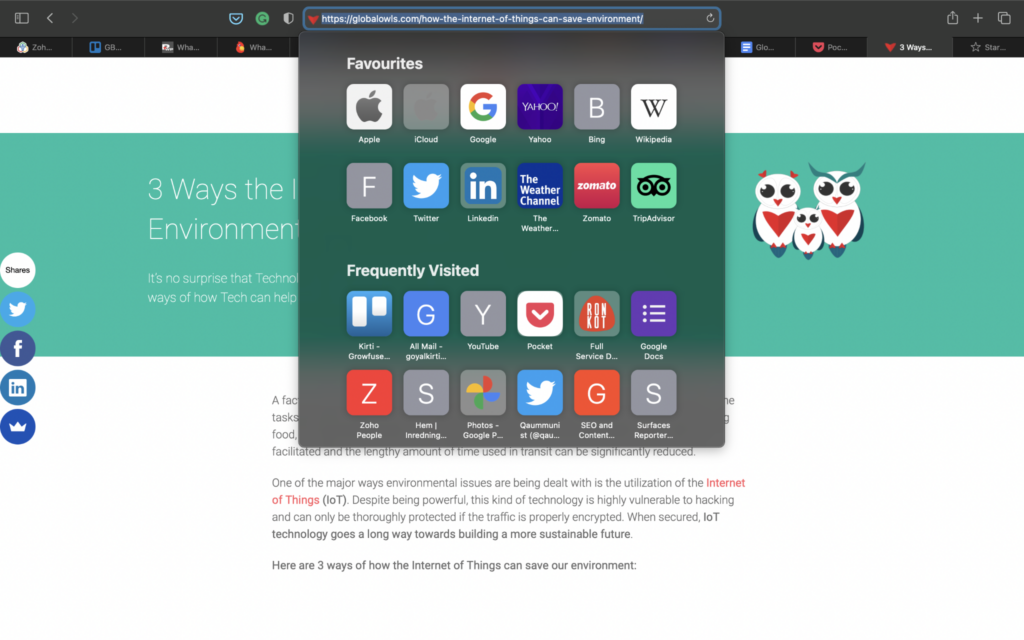
By including relevant phrases, a slug enables search engines to better understand the content of a page. But it serves other purposes as well. A slug adds credibility and prompts the readers to click through a URL in the SERPs.

Notice how Hootsuite, Buffer, and WordStream have added slugs to their pages. These details make them trustworthy and clickable when compared to the default “domain.com/?p=123” on WordPress.
Focus on the following areas to optimize default slugs:
- Keywords: Include the keyword phrase you want to rank for. While there are various ways to do this, stick to the following general format- domain.com/topic-mentioned-here.
- Title: Do not duplicate the title of your page in the URL. Instead, try to resemble it using fewer words and lowercase.
For example, a blog with the title “How to Generate Leads for Your Business” can have “lead-generation-strategies-for-business” as a slug.
- Hyphens: Use hyphens and underscores to separate words. They improve the readability of slugs, thus making them easier to understand.
- Unnecessary words: Omit pronouns and prepositions like ‘a,’ ‘the,’ and ‘too.’ These are ‘stop words’ that do not bring any value to search bots or readers.
How to Edit Slugs in WordPress
As the below image shows, the default permalink structure includes the domain name and random characters. It is not SEO-friendly and needs to be updated.
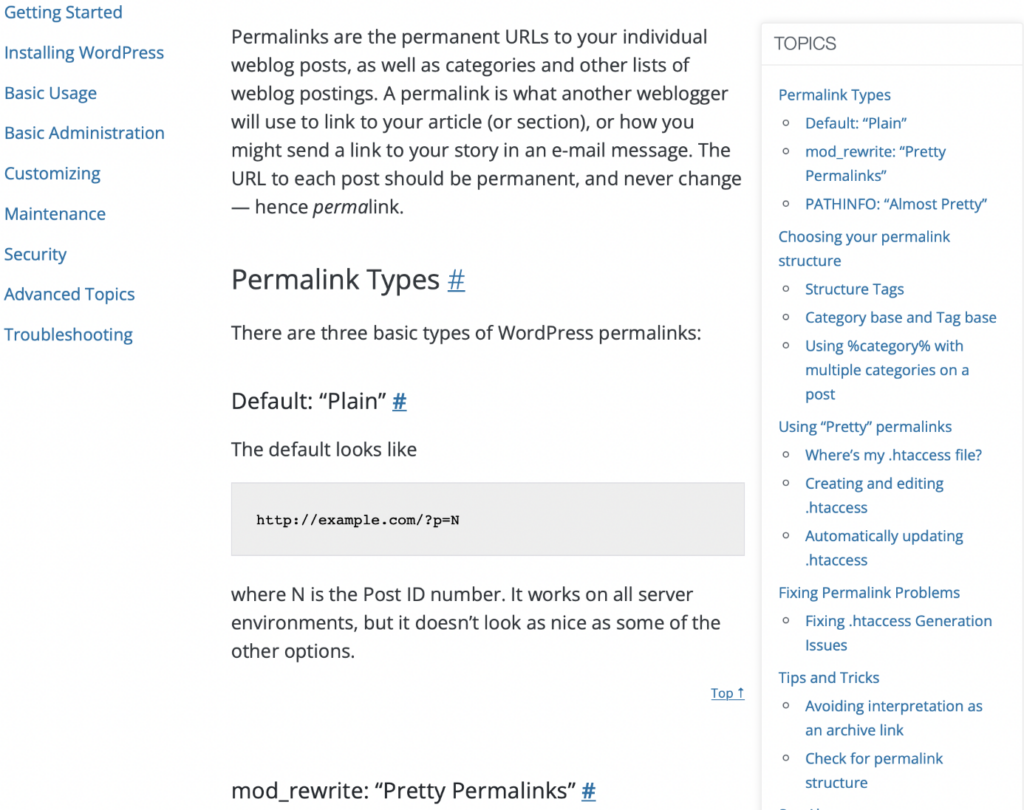
You must change the permalink during the setup process. Otherwise, it will lead to broken links on your website. While WordPress offers six options to choose from, we suggest ‘Post name.’ This is because it is the shortest and permits keywords.
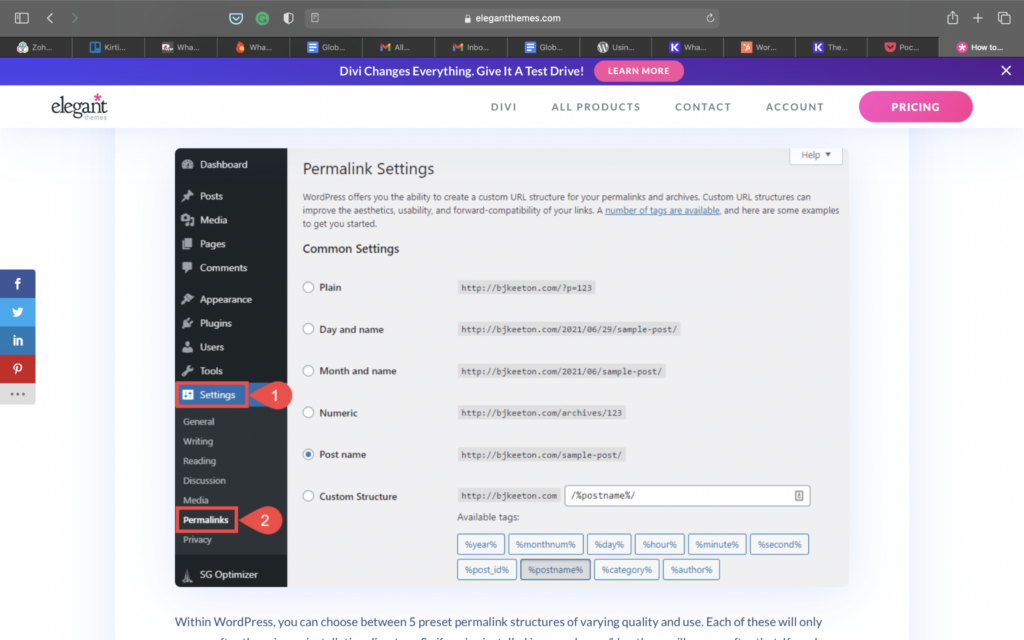
After changing the permalink settings to ‘Post name,’ follow these steps to edit the slug of individual posts:
-
- Go to ‘Posts’ in the WordPress dashboard and select ‘All Posts.’ For pages, select ‘All Pages’ under ‘Pages’ and follow the same process hereon.
- Come down to the post you want to edit and open ‘Permalink’ from the right-hand side of the screen.
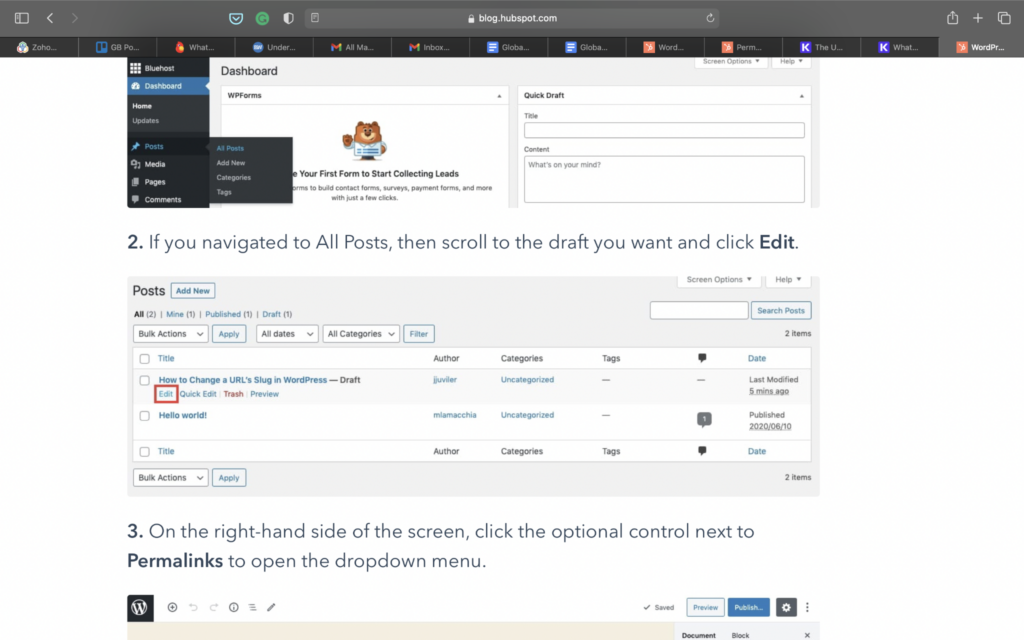

3. In the ‘URL Slug’ column, add the keywords you want to rank for and save the changes.
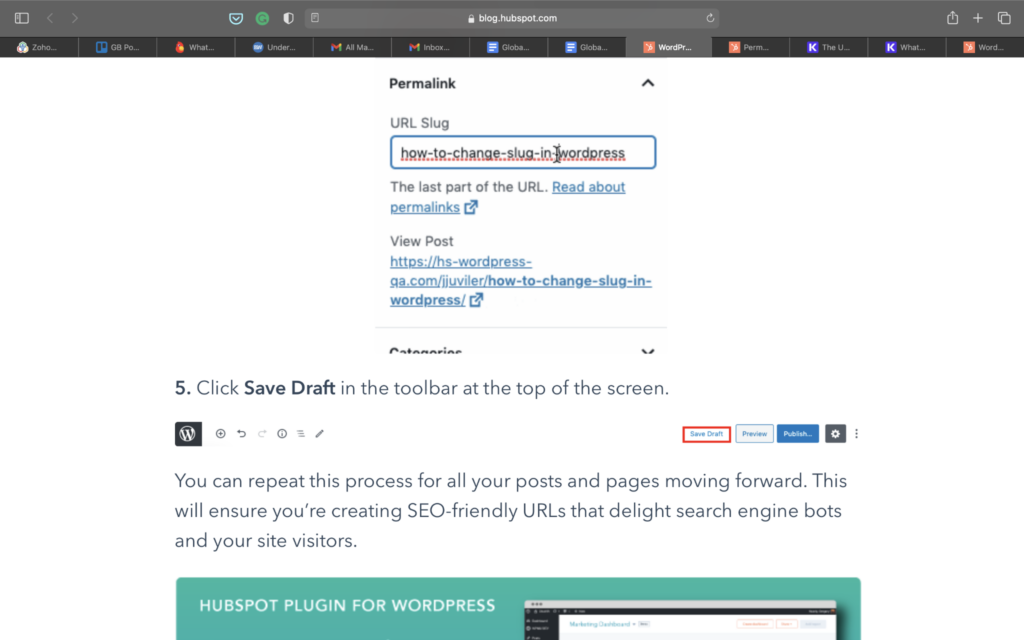
Troubleshoot Slugs
As we mentioned before, you will have to deal with broken links if you change the slugs post website setup. WordPress tries to redirect the users in such a case, but it doesn’t always work. If not fixed, the visitors will land on the dreadful 404 pages.
Like web design, well-connected links are central to a frictionless user experience. Hence, use 301 redirects to retain users and any link juice the old slug gathered. Either involve your in-house team to set up 301 redirects or outsource it to expert developers to ensure that your WordPress site remains optimized for performance.
WordPress Permalinks
The part of the URL that tells WordPress where to file slugs is a permalink. Unlike URLs that may contain details about subdomain, domain, and path, bloggers have made permalinks famous for SEO purposes. The image below will make it clear.
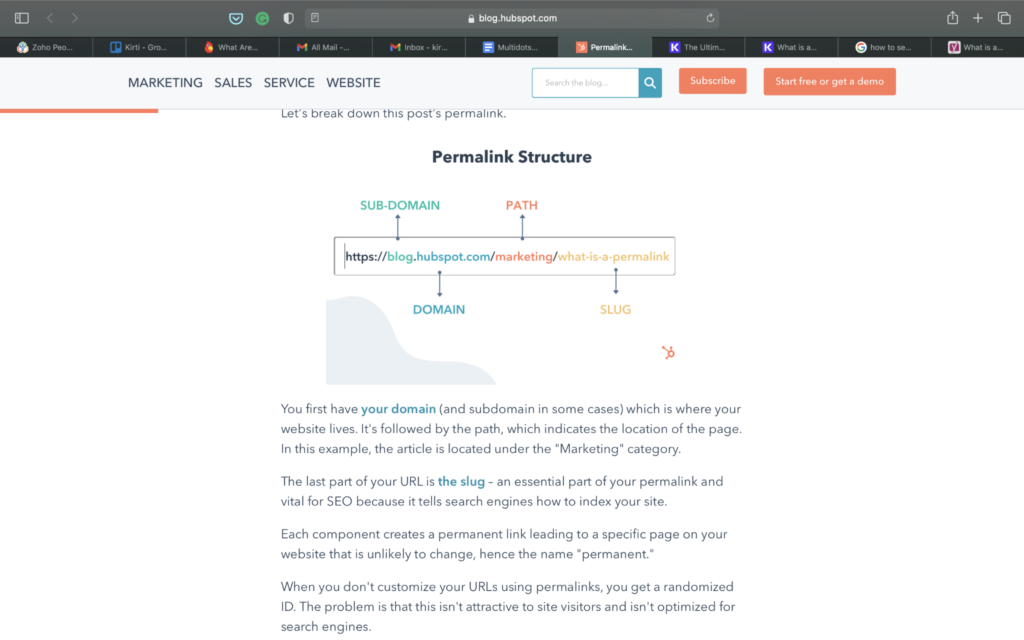
On removing the path (a custom taxonomy) and slug, the above link will perfectly function as a URL. It is a permalink because it helps Google to find a specific web page on HubSpot, listed under ‘Marketing.’
This means that every permalink is a URL but the opposite is not true. While URLs direct web browsers to pages on a site, permalinks modify URLs to make them SEO-friendly. To ensure that URLs perform in the SERPs, pay attention to these elements:
- Structure: Analyze your content and audience to decide a format for the permalink structure. For instance, a blog that is regularly updated will not benefit from a date-type slug. Instead, it will make your content appear outdated to online users.
- Slug: Multiple keywords in a slug will hurt your SEO rather than strengthen it. Thus, pick a relevant keyword that best describes your blog and leave the rest to its content.
A duplicate slug is equally harmful. It can create crawling errors and wrongly signal to Google that the page contains duplicate content. To avoid this, choose a unique text for slugs.
How to Edit Permalinks
A permalink has two parts: the domain and the slug. To edit permalinks means changing either of the two. The above best practices for slugs will automatically edit the permalinks. But changing the domain is an entirely different matter.
If you migrate your site to a new domain address, then the change in the permalink for your pages will be due to the domain, not a slug.
Troubleshoot Permalinks
The URLs of custom posts and taxonomies in WordPress are slightly different from regular pages due to custom IDs. In place of “domain.com/slug” URLs, they have “domain.com/customID/slug”.
Permalinks may not work properly if you register a custom post type or taxonomy. To fix the issue, simply refresh the permalink settings. However, if the error is due to another reason, try these tips:
- Go to permalink settings and ensure that tags and syntax are correct.
- Clear your website’s cache to prevent it from interfering with changes to links.
- Deactivate any plugins that affect post type or links.
- Edit website content for outdated links that come up due to changes in permalink settings.
- Check if the slugs are in line with best practices and need editing.
Conclusion
An optimized URL makes it easier to rank in the SERPs. By adopting the best practices for slugs and permalinks, businesses can boost their CTRs. Follow the tips shared in this post and never miss out on a chance to boost SEO, make a handsome profit and boost your WordPress skills!
If you don’t have the time to make these optimizations yourself or you think it’s too daunting, you can always opt-in for a company that provides WordPress development services. For businesses looking to expand their offerings without building from scratch, considering a white label WordPress development solution can be a strategic move. Make a list of all the optimizations you want to have done and chat about it with professionals.
Author:
Lucy is a creative content writer and strategist at Marketing Digest. She specializes in writing about digital marketing, technology, entrepreneurship, and education. When she is not writing or editing, she spends time reading books, cooking and traveling.
FAQ
What Is the Difference Between a WordPress Slug and Permalink?
A WordPress slug is a part of a URL that represents a specific post or page, while a permalink is the entire URL structure, including the domain name and slug.
How Is a WordPress Slug Generated?
A WordPress slug is typically generated based on the title of the post or page. It is a URL-friendly version of the title with spaces replaced by hyphens and special characters removed.
Can You Customize WordPress Slugs?
Yes, you can customize WordPress slugs to make them more descriptive and SEO-friendly. This is especially useful for improving search engine optimization (SEO).
What Are Permalinks in WordPress?
Permalinks in WordPress are the permanent URLs that point to your posts, pages, and other content on your website. They help visitors and search engines find and navigate your site.
How Do I Set Up Permalinks in WordPress?
You can set up permalinks in WordPress by going to the Permalinks settings in the dashboard. There, you can choose from different permalink structures or create a custom one.
Why Are Permalinks Important for SEO?
Permalinks play a crucial role in SEO because they help search engines understand the content and structure of your website. Descriptive permalinks with keywords can improve search rankings.
What Are Some Common Permalink Structures in WordPress?
Common permalink structures include “Plain,” “Day and Name,” “Month and Name,” “Numeric,” and “Custom Structure,” which allows you to create your own format.
What Should I Consider When Choosing a Permalink Structure?
When choosing a permalink structure, consider your website’s content, the type of information you want to convey in the URL, and the SEO impact of the structure.
How Can I Edit or Update a WordPress Slug?
To edit or update a WordPress slug, you can do so within the post or page editor. Simply edit the slug field located below the post title.
Are There Any SEO Best Practices for WordPress Slugs and Permalinks?
SEO best practices include using descriptive slugs with relevant keywords, keeping permalinks concise, and avoiding special characters or unnecessary words for cleaner URLs.
Create more and better content
Check out the following resources and Grow!